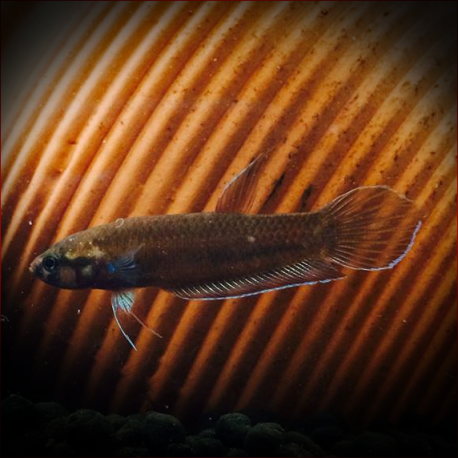More info
Datasheet
| Minimum Tank Size | 40 litres / 10.57 US gallons |
| Maximum Size | 3.5cm / 1.38inches |
| Temperature | 22°C / 71.60°F - 27°C / 80.60°F |
| Hardness | 1.01dgH / 18ppm - 5.04dgH / 90ppm |
| pH | 5.0-7.0 |
General Description
The Betta Dennisyongi species is a member of the Betta rubra group within the genus Betta, characterized by specific shared traits. These fish are typically small in size, with mature males showcasing broad black lateral bars while females and juveniles possess a longitudinal black lateral stripe. With a maximum size of up to 3.5cm, Betta Dennisyongi has intricate body coloration and specific morphological features that distinguish it from other members of its group.
Aquarium Setup
Betta Dennisyongi can thrive in a fully-decorated aquarium, with driftwood, roots, branches, clay plant pots, and leaf litter serving as suitable elements for shelter and natural aesthetics. Maintaining dim lighting conditions, including aquatic plants like Microsorum or Cryptocoryne spp., and floating vegetation are beneficial for their habitat. Soft water with minimal carbonate hardness and low general hardness is crucial, which may require filtration through methods like a reverse osmosis unit. The tank should be well-covered, not completely filled to allow access to a layer of humid air, and equipped with gentle filtration to promote a suitable environment for Betta Dennisyongi.
Behaviour
Betta Dennisyongi is best kept alone or with peaceful species, as larger or more vigorous fishes can intimidate or outcompete them. Compatible tank mates include small cyprinids and loaches from similar environments, with caution advised when maintaining in pairs or harem-type groups due to potential aggression towards conspecifics. Observations suggest occasional territorial squabbles with minimal physical harm. These fish possess a labyrinth organ, allowing them to breathe atmospheric air, enabling adaptation to various ecological niches.
Feeding and Diet
In their natural habitat, Betta Dennisyongi primarily feeds on insects and small invertebrates, a diet that can be replicated in captivity. They readily accept dried foods but should be provided with live or frozen options such as Daphnia, Artemia, or bloodworms regularly to enhance coloration and overall health. Supplementing with small insects like freshly-hatched crickets or fruit flies after feeding them fish flakes or vegetable matter is recommended. Care should be taken to avoid overfeeding as Betta species are prone to obesity.
Reproduction & Dimorphism
Betta Dennisyongi is a paternal mouthbrooder, requiring a separate breeding tank with a tight-fitting cover to ensure adequate development of the labyrinth organ in fry. The courtship process involves the male wrapping around the female, with the female carrying the eggs. The male then collects the eggs in his mouth, incubating them for 10-17 days until free-swimming fry emerge. Males exhibit more vibrant colors and extended fins compared to females, allowing for easy sexual dimorphism identification.
Habitat and Distribution
These fish are native to lowland hill streams and acidic freshwater swamps in northwestern Sumatra, Indonesia. Typically found in environments with clear to brownish water and submerged leaf litter, Betta Dennisyongi coexists with various fish species like Osteochilus jeruk and Rasbora jacobsoni. Their distribution is limited to the western coast of central Aceh province in Indonesia, showcasing specific habitat preferences and limited geographic range.

